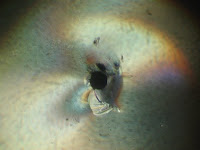
Glass expert analyzed a broken tempered glass door. He was able to preserve the origin and perform a failure analysis. The spontaneous glass failure started in the center of the window and was caused by a nickel sulfide particle (NiS particle). This failure mechanism is well known and has been documented by others. In this case, the glass expert spent some time documenting the initial crack growth. The upper left photomicrograph shows two sets of Wallner lines spreading away from the general location of the 100 micron diameter spherical nickel sulfide particle. The photomicrograph on the upper right shows a circular crack arrest line surrounding the NiS particle. This circular artifact identifies the NiS particle (a manufacturing defect) as the cause of the failure. In addition, it also indicates that the crack stopped at least once before the glass went to failure. At first the crack started as a round crack due to the stresses from the nickel sulfide particle. Later the residual stresses in the glass took control. The circular crack opened up and turned into the classic sets of Wallner lines found in root cause failure analysis of tempered glass.





